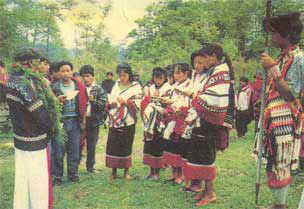| People  The
population of Nagaland is entirely tribal. The Nagas belong to the Indo-Mongoloid
family. The fourteen major Naga tribes are the Angami, Ao, Chakhesang,
Chang, Khemungan, Konyak, Lotha, Phom, Pochury, Rengma, Sangtam, Sema,
Yimchunger and Zeliang. The
population of Nagaland is entirely tribal. The Nagas belong to the Indo-Mongoloid
family. The fourteen major Naga tribes are the Angami, Ao, Chakhesang,
Chang, Khemungan, Konyak, Lotha, Phom, Pochury, Rengma, Sangtam, Sema,
Yimchunger and Zeliang.
The Chakhesangs were earlier known as Eastern
Angamis and are a combination of the Chakri, Khezha and Sangtam
sub-tribes. Now the Chakhesang tribe is spilt further; Pochury's
who were earlier a part of it now claim a distinct entity. Each
tribe has their own languages and cultural features. Literacy is 61.30
%. The population has shown a steady upward trend.The Naga's have different
stories about their origin. The Angamis, Semas, Rengams and the Lotha's
subscribe to the Kheza-Kenoma legend. It is said that the village
had a large stone slab having magical properties.
Paddy spread on it to be dried doubled in quantity by evening. The
three sons of the couple who owned the stone used it by rotation. One
day there was a quarrel between the sons as to whose turn it was. The
couple, fearing bloodshed, set fire to the stone which as a result cracked.
It is believed that the spirit in the stone went to heaven and the stone
lost its miraculous properties. The three sons thereafter left Kheza-Kenoma,
went in different directions and became the forefathers of the Angami,
Sema and the Lotha tribes. According to another legend, to
which the western Angamis subscribe, the first man evolved from a lake
called Themiakelku zie near Khonoma. The Rengmas believe that until recently
they and Lothas formed one tribe. The Aos and the Phoms trace their origin
to the Lungterok (six stones) on the Chongliemdi hill. Some people believe
that these Indo-Mongoloids are 'kiratas' frequently mentioned in the old
Sanskrit literature of whom 'Nagas' were a sub-tribe. 
The hill tribes in the areas now known as Nagaland had
no generic term applicable to the whole race. The word 'Naga' was given
to these hill tribes by the plains people. This proved to be a great unifying
force to the tribes now classified as Naga. Nagas are of sub-medium height,
the facial index is very low, the nasal index corresponds to a medium
nose, the hair is generally straight, the skin is brownish yellow. The
eyes significantly do not show Mongolian form.
It could broadly be said that they are straight
forward people, honest, hardworking, sturdy and with a high standard of
integrity. They are lacking in humility and are inclined to equate a kind
and sympathetic approach with weakness. The Nagas have a very strong sense
of self respect and would not submit to anyone riding roughshod over their
sentiments. The Angamis are politically the most conscious group. The
Zeliang and Pochury tribes in Kohima district are comparatively simple
and unsophisticated. The Tuensang tribes are un-spoilt children of nature.
A striking characteristic of the Naga tribes is their hospitality and
cheerfulness. To be greeted with a smiling face while traveling on the
roads is a common experience. A visitor to Naga village is heartily received
and entertained with a surfeit of rice-beer, which is generally served
by the lady of the house or her young daughter with a warmth which is
unforgettable. |


